Day 17, April 23: Frómista to Carrión de los Condes (22.6 km, 14 miles)
I could hardly wait to get on the road today if only because I loved the idea that, as the post title suggests, I would be “carrying on to “Carri… on” (the Spanish pronunciation doesn’t exactly support the word play, but I get a kick out of it nevertheless…)
But the post didn’t happen, did it? Instead you got “a lick and a promise.” Now, as evening descends on Wednesday, I’m trying to deliver on the promise, and fortunately I have some notes from yesterday to help jog my memory. Necessary because, believe me, it is so easy to have the days blend into one another and to forget the details. (I have to say: I got a very positive response from the short “lick and a promise note,” no doubt heartfelt appreciation for the short post and a desire that I produce more of same: short, sweet, to the point. An update without the details…. But, recall, I’m doing this blog as much as anything to keep my memories live. Thank you for “dealing with it”!)
So, then, back to Frómista, the town along the canal, the town with the locks, the albergue I barely managed to get back to, my left-over dinner in a bag, before the front doors were locked, the long blog post that kept me up past midnight. We continue, then, from that point:
It was a surprise when the lights came on in the morning to find that Nadine and Françoise, the two French ladies whom I had introduced, were in my room, Nadine directly under me (I had suspected when I saw the napping figure under me in the afternoon that it was Nadine, but I hadn’t had a chance to confirm that; it had been a busy afternoon). It was funny about the bunk beds in that room. Whenever Nadine had turned over in the night, my top bunk jiggled around. The first time it happened I must have been asleep and for a brief time I thought it was Ken turning over next to me…. but wait a minute, that can’t be! Then I figured it out. From then on, I tried to turn very carefully so as not to give Nadine the same eerie experience.
I was the first one up in our section of the sleeping quarters, but the very last walker out of the hostel in the morning, maybe around 8:20. (Another woman was leaving just a few minutes after me, but she was planning on calling a taxi to take her somewhere or other). My late delay was due to spending a bit of extra time treating my feet. Having bought some made-in-house “snake oil” and a scissors at the pharmacy, I was going to try a new technique with a couple of blisters. (Not bad, mind you, but hoping to avoid something worse.). The other reason for my delay: I had the yummy leftovers of risotto and tripe in the refrigerator. Plate-licking good!
I’d been told at dinner the night before that I had missed a treasure by failing to at least walk by the church of San Martín the day before. I quote from my guidebook: “consecrated in 1066 and reputedly one of the finest examples of pure Romanesque in Spain.” The book warns that it has lost some of its charm because now it has become a national monument, a “must-see” tourist site with “endless coach parties” arriving to visit. Believe me, there were no coach parties at 8:30 am. I had the (exterior of) the church to myself. I concur: it was beautifully proportioned. As I think I’ve mentioned, I prefer the Romanesque style to Gothic and Baroque. Keep it simple, no?
And finally, I’m on my way out of town, meeting up almost immediately with Arancha and Iván, a young Spanish pareja (“no, no,” they assured me, “not a matrimonio,” as if being married was a fate to avoid at all costs). They do a holiday every year on one or another stretch of the Camino. Eventually they will make it to Santiago.
The forecast called for rain. While not a terribly cold day, neither was it very warm. I was content with my wool shirt, my Polartec vest, and my winter jacket. I hung my rain jacket on the outside of my pack for easy access. The sky (all day) looked like rain would begin at any moment. The joke was actually on the people who left at 7:00 or even earlier, trying to get ahead of the rain. They got wet. I got the merest bit of spit mid-morning, but that was it. I wasn’t upset….
For once I had paid some attention to the maps in my guidebook (contrary to the day before when coming upon the Canal de Castilla took me totally by surprise; a pleasant surprise). I saw that the main route followed the highway all day, whereas there was an alternate route that went along a river. Duh! The alternate only added .9 km. Who wouldn’t choose it? Most people, apparently. Whether from not noticing that there were yellow arrows at the same junction pointing in two different directions, or whether due to a preference for moving along more quickly without fear of muddy pathways, or whether because of a preference for passing two additional towns if one continued along the path that paralleled the highway (thus, bathrooms and the possibility of food and drink), I know not. Whatever, I had the path, which met up with the river after a kilometer or two, practically to myself.
Was I making a mistake? Just on the outskirts of the village, I spotted a local. “You don’t want this way,” he tells me. “Everyone goes the other way. There aren’t any services along here.” “Yes, but no traffic either,” I responded. After the breakfast I had had, who needed “services”? The man was accompanied by two greyhounds. “Do you race them?” His face lit up as he nodded. I’m neither a fan of greyhounds nor of the notion of having them race each other, but I have to say: they were beautiful dogs. The one, 5 years old, slowing down a lot; the other, at age 2, in her prime.
Such interactions are a joy for me. Just a little snippet of conversation, a bit of curiosity on the native’s part about my castellano, and then onward. The town I had just left has a population of 150, but at least two of the gents there liked to walk. I soon met up with another fellow, 60ish. He was out for his daily constitutional. “10 kilometers, most days,” he told me. Sometimes alone, sometimes with friends. “Ventajas y descventajas,” he commented. Yes, I knew what he meant. Sometimes one likes the conversations one has with oneself, sometimes others can be good company, make the time go faster. “But it’s good to go each one at his own ritmo.” Again, I concur.
As I was conversing with this gentleman, a few pilgrims came along. Irish. “No hablo inglés,” he tells me. “Just one thing,” and he goes on to tell me what that is: “I don’ know.” “I’ll teach you another,” I said. “Repeat after me: ‘I don’ speak English’.” He was at first puzzled, then caught on and repeated as requested. I was able to congratulate him and then… then it was time for him to turn to the right and head off on a ploughed path to complete his 10-k loop. More power to him. He and I both agreed that the world would be a better place–and a healthier one!–if everybody did what he did. (I had asked him if he ever had done the Camino. He laughed as if to say: “10 kilometers is a worthy goal; the entire Camino an estupidez!” To each his own.
Soon afterwards I arrived at the point where the path follows along the River Ucieza (say that with the proper Castilian pronunciation and you’ll have a real tongue-twister going!). It was lovely. The river sometimes had a decent flow to it, sometimes was more like a creek, even like a somewhat dry creek. And then again soon, more water. Surrounded on both sides by tall waving “grasses.” I found myself picturing Moses floating by among the bulrushes. Beyond the river, to my right, views of the meseta. Very peaceful. Enjoyable. Far to my left, for a while, I could discern the pilgrims following the highway, the bright colors from their rain ponchos and pack covers making them a highly visible, even cheerful sight. Still, I was glad to have found, again, the road less traveled for about 8 kilometers or so until the “river way” met up again with the main route. For company, I heard the cuckoo and the dove competing with each other and with the wind to see who was most important for the morning’s symphony. To my mind it was a toss-up between the cuckoo and the wind.
The two routes merged at Villalcázar de Sirga, a town dominated by the fortress-like 13th-century church of Santa María la Virgen Blanca which houses a revered statue of the same name. I picked up a brochure which brought back to me having read some medieval poetry by Alfonso el Sabio (Alphonse the Wise) back in graduate school days in which he praised the virgin for the miracles she wrought. It was a very pretty church and more than worth the 1 euro “pilgrim priced” entry fee.
And, in the plaza right in front of the church, one of the finest desserts I’ve ever had: kind of a cross between sugar-cream pie and very nice custard, topped with glazed apples. It went so much better with the coffee I had ordered than the “potato omelette” I had planned to order. No apologies for my sweet tooth on this day. I ate my pie at a table with two new-to-me Irishmen. One I had seen in the church lighting candles and offering some prayers. The other one, the one who lingered at the table, was more of a sceptic. H wasn’t quite sure about “all this Camino business,” and felt sure that this one go-’round on it was all he fancied. “Too much myth, too many tears and emotions. None o’ that for me. I don’t really see what all the fuss is about.” To each his own. I had only sat down at the table with him because I mistook him for my English photographer friend whom I had also seen in the church and with whom I had a lot more in common. Oh well….
I arrived at journey’s end about 3:00, and once Sister had efficiently explained the rules–no wasted time for her!–and had found me a bed, I located Ginny down in the dining room and was delighted to indulge in the soup she had prepared.
That soup: let me just say that the Camino continued to provide. Earlier that morning one of the sisters in charge, having learned that Ginny had cleaned up the entire kitchen–dishes, counters, stove top–and had wiped down all the tables, gave a nod to Ginny about using up any food she found around. Don’t suggest it twice, sister! Soon Ginny was at work, boiling beans and letting them rest, cutting up left-over meats and vegetables, tomatoes… She headed to a panadería for fresh-baked bread to accompany her “stone soup,” then went about the business of sharing it. A bowl for Irish Teresa whose husband Vincent had taken ill and who, like Ginny, had been allowed to remain a second night at the hostel, a bowl for me, one for Nadine who had arrived a bit after me. Ginny’s work was therapeutic for her and certainly tasty and nutritious and very welcome.
The rest of the day went by in a blur: some massage time on Ginny’s cranky knee administered by the none-too-professional-but-very-willing cousin, lots of consulting back and forth about Ginny’s next move which will be to the large–130,000–city of León. That’s a four-stage jump down the Camino; she’ll spend three nights at an Airbnb until I catch up with her on Saturday evening at an albergue.
Speaking of catching up, that’s you, all caught up on Tuesday’s adventures up to the point where I chimed in with that “lick and a promise” post. And now, I’ve delivered; you got the whole meal only hinted at by last night’s lick.
Whether you wanted it or not….
PS. Many thanks to Regina who has better internet with which to upload some photos. Would love to be sharing a great many more, but that’s one challenge that I’m not meeting very well. So be it.
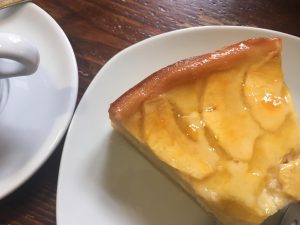
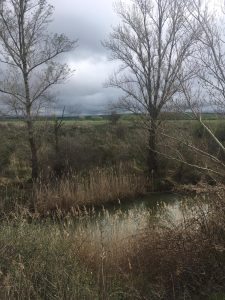
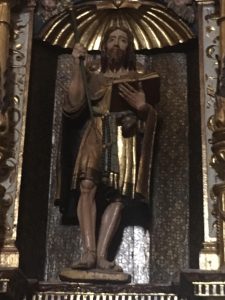
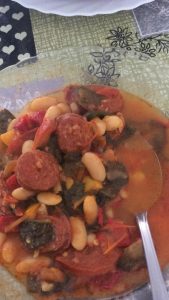

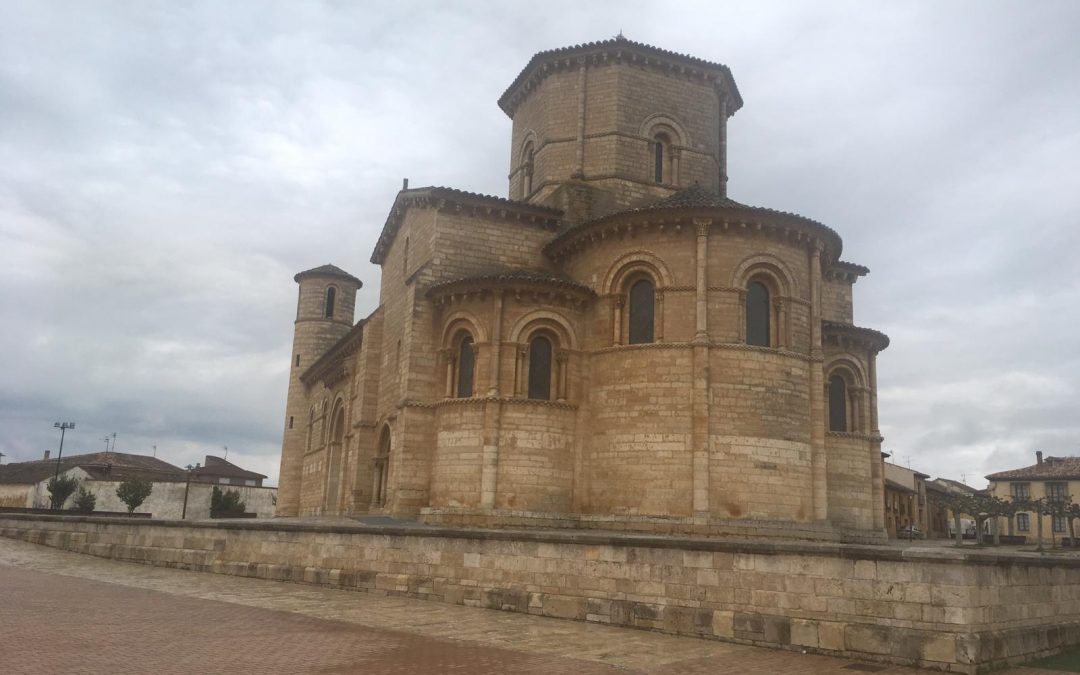
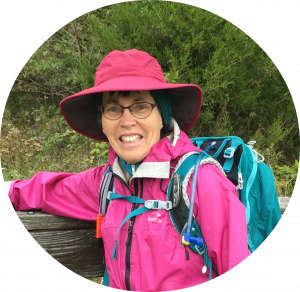
Your greyhound-man story reminded me of the time we got off our Viking cruise ship to walk to the nearby German village. A man was walking his dog and we greeted him in German. He appreciated that and went on to warn us for a swan that was nesting in the grass between the river and the walkway. Don’t get too close: the swans will get VERY mad! Thank you, sir, we will be sure to keep our distance.
Snippets of conversation that can make your day.
Yum! Love your conversations with those on thr same road… Literally and spiritually!
I was worried about Ginny so glad you met up. It sounds like the knee is not getting better.
I’m not so sure about that “Meseta” you’re on, particularly in the rain. It’s tad too bleak for me. Also, I make the mistake of reading your posts before eating something first, so I wind up starving for home-made soup, fresh-baked bread and a quarter-pound of butter.
You must be dying to see a tree. I know how much you like them. When I walked the local cemetery earlier this morning, I tried to stay behind big trees as I sang that “Hope” song from the other day. I thought I was alone, but I wasn’t. Two Mexican groundskeepers suddenly came out from behind some bushes and just looked at me, wide-eyed, wondering what the hell. If I sing again, I’ll get arrested, I know it. People don’t go for that stuff around here, being Mt Greenwood, where too many cops and too many firemen are on the prowl for crazy people who can’t behave in the presence of the dearly departed. (Of course, I needn’t bellow to the treetops either.)
I think of Ginny more and more. Sure, she’s making the best of it, I know, but still. Give her my best when you catch up with her in a few days.
Later,
Jim
Loved you description of walking along the river by yourself rather than on the highway with the other pilgrims. Your posts are such an inspiring story of enjoying “alone time” and times when you have special interaction with others. Blessings on your wonderful journey.
I feel so totally privileged to to be on this journey!
Hope all is going well for you. I could sure use some German on this journey. Many Germans here! (Lots of “from everywhere” here!